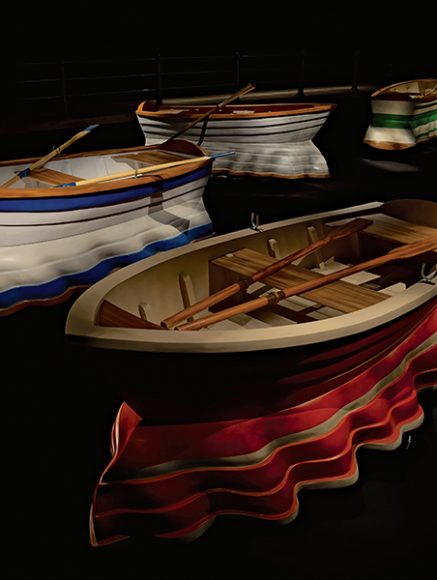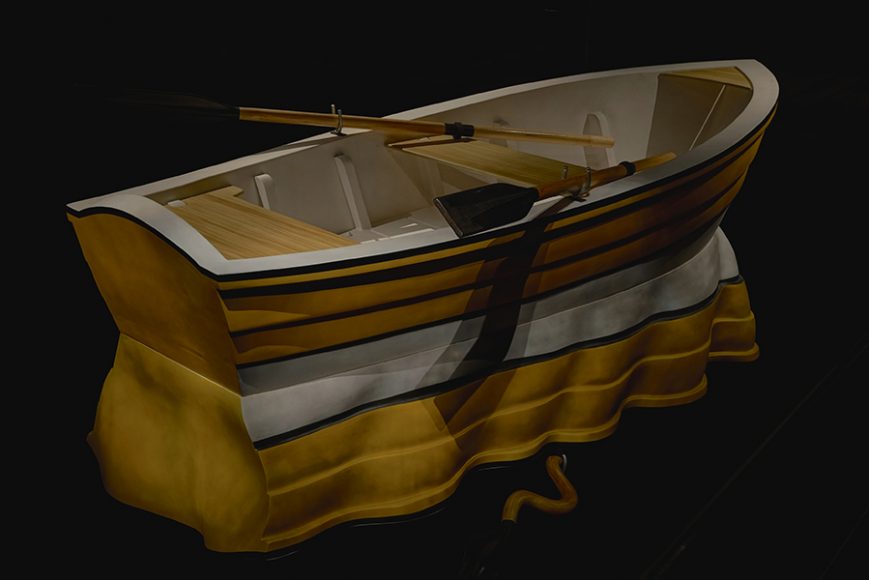A window onto a city thousands of miles away. A house rooted in the air. A mirror that reflects everything but the person gazing into it. People walking and talking under water or hanging out — on the outside of buildings.
They’re all part of the illusory world of Leandro Erlich, a peripatetic polyglot from Argentina who’s one of the most magical installation artists around. But the soft-spoken, unassuming Erlich, who made a stopover at Purchase College’s Neuberger Museum of Art recently for his latest show, “Port of Reflections,” isn’t interested in fooling the public.
“I think that revealing the trick is crucial,” he says in a quote accompanying the exhibit. “That revelation transforms the ‘deception’ into something positive. I want the spectator to think and discover.”
In “Port of Reflections” (through July 30), Erlich — winner of the 2017 Roy R. Neuberger Prize for conceptual art — pulls out all the stops to consider the fluidity of appearance and reality, and our perceptions of both. He has transformed half of the Neuberger’s 5,000-square-foot Theater Gallery into an indoor harbor complete with five rowboats that bob in the “nighttime water,” their bright colors as brilliantly reflected as if this were Claude Monet’s 1874 oil on canvas “Sailboats on the Seine at Petit-Gennevilliers” (pictured in the accompanying catalog) come to three-dimensional life.
Of course, the installation is neither a 3-D Monet or an actual harbor recreated indoors. The effect of boats rocking in the water at night was created using black felt and an electromagnetic system, says Patrice Giasson, the Neuberger Museum of Art’s Alex Gordon associate curator of art of the Americas, who organized the show with Helaine Posner, the museum’s chief curator. Erlich fashioned the boats so that the bottoms are the wavy reflections of what the boats would look like were they in actual water. That they came to the Neuberger by boat is an irony not lost on the curators. “They were shipped by ship,” Posner says.
It took a month to complete the installation, which includes a ramp that gets you in the mindset for boarding your adventure. Once inside the darkened space, the ramp becomes a “boardwalk” and “pier.” You can almost scent the tang of the saltwater tantalizing the nostrils, the damp night air pricking your skin. And yet, you know the scene is not real. The boats are pristine in their creamy, gumdrop colors — with nary a barnacle in sight. The scene is at once theatrical and ordinary, with the line between the two as thin as the vaporous blue edge where the sea meets the sky.
Curator Giasson locates Erlich’s illusory art in his architectural background. (His brother is the architect Esteban Erlich of the New York firm studio ai architects.) In the late 1990s, Leandro Erlich participated in the Core Residency Program at The Museum of Fine Arts, Houston’s Glassell School of Art. Then he moved to New York, where he had his first show in a commercial gallery.
Erlich took part in the Whitney Biennial (2000) and represented Argentina in the 49th Venice Biennale (2001). He lived and worked in Paris for a few years, then came back to Buenos Aires. There he returned to the idea of engaging the city’s historic Obelisco (Obelisk), which stands in the Plaza de la República at the intersection of avenues Corrientes and 9 de Julio. He “decapitated” the obelisk by placing a box made of similar material and containing cameras over the top of the impenetrable, enclosed 220-foot structure. He then placed a pyramid resembling the top on the ground near MALBA, the Latin American Art Museum of Buenos Aires, and installed monitors in it that presented the images being recorded by the cameras on top of the Obelisco.
The effect of “La Democracia del Simbolo (The Democracy of the Symbol)” (2015), as documented in images of its construction, is at first dizzying, disorienting and disturbing. But then you realize that Erlich gave citizens and visitors something they never had before — a view from the top.
So it goes for Erlich. For “Paris-Delhi-Bombay” at the Centre Pompidou in 2011, he gave viewers “Le Regard (The Gaze),” a typically bourgeois apartment in Paris that opened onto a street scene — in Bombay (Mumbai). He has given Cubans in Havana an opportunity to play at being Swiss ski bums, thanks to the magic of Polaroids (“Turismo,” 2000); New Yorkers at MoMA PS1 a chance to walk and talk under water, thanks to an acrylic sheet covered by a few inches of water (“Swimming Pool,” 2004; 2008-10) and everyone from Londoners to Ukrainians a moment to hang from a building. (It’s done with mirrors, in this case a huge one set at a 45-degree angle that reflects the building façade created on the ground.)
For Erlich, it’s all about place and displacement and knowing that when you understand that everything is constructed, even reality, then you are in the place just right.
For more, visit neuberger.org.







